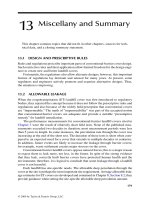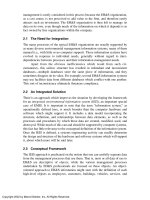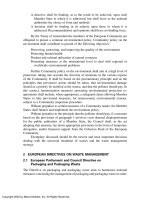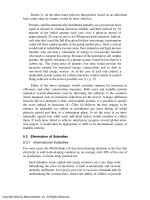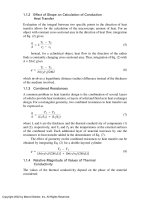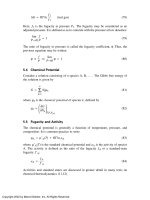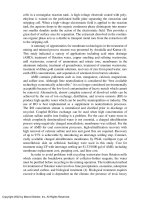Handbook Of Pollution Control And Waste Minimization - Chapter 16 ppt
Bạn đang xem bản rút gọn của tài liệu. Xem và tải ngay bản đầy đủ của tài liệu tại đây (267.1 KB, 6 trang )
16
Application of Life Cycle Assessment
W. David Constant
Louisiana State University and A&M College, Baton Rouge, Louisiana
1 INTRODUCTION
Application of life cycle assessment (LCA) ensures that environmental impact is
explicitly included in the design process, yielding the “best” alternative. The
“best” choice can be difficult in the final analysis to assess, as many factors may
cause an objective LCA to fall into a gray or subjective area. Graedel (1) presents
an excellent methodology for streamlined LCA with a matrix approach, yielding
objective results, and explores the approaches used by major manufacturers in
obtaining data for the matrices. Others (2,3) present basic studies and applica-
tions, and there are many articles and texts available between basics and detailed
methods. The objective of this chapter is to explore the application of LCA for
waste site remediation, as an example of the extension of LCA to areas beyond
manufacturing goods and consumer products.
2 BASICS FROM CHEMICAL ENGINEERING
Application of LCA to assess a waste site remedy is making use of the basics of
chemical engineering and related fields, the material and energy balances, with a
few other topics included, such as economics, eco- and/or health risk assessment,
Copyright 2002 by Marcel Dekker, Inc. All Rights Reserved.
and regulatory constraints. Key components for assessment in the material and
energy balance approach are (a) the problem basis, (b) boundaries, (c) generation
and accumulation, and (d) time. These terms and their components must be
consistent in analysis of, for example, technology comparisons in remediation or
waste management methods for treatment of a process stream or contaminant-
media matrix. In terms of a general equation, we may write for any LCA
assessment:
Input = output + generation + accumulation (1)
It should be noted that the generation term may be positive or negative
(if material is consumed). It is critical that the terms are handled in a consistent
fashion for use in LCA. The basis of “measurement” is key—should we look at,
as with paper cups versus ceramic cups, the number of cups or the number of
cups per use? The decision depends on what we are investigating in the LCA.
Also, in extension of LCA to site remediation, the value of the source term, for
example, the mass of waste within the source of a groundwater contaminant
plume, may be very difficult to obtain without significant uncertainty associated,
making the LCA an estimate with significant error. The accumulation term is
critical for understanding the burden with time for unsteady-state processes. Since
time is included in the accumulation term, the length of the LCA, or time line,
must be selected initially to satisfy stakeholders in the application (regulators,
landowners, industry, public, etc.). One should determine what interval for study
is appropriate, as regulations use years, decades, and in some cases centuries as
windows into model predictions of the fate and transport. Generation components
will include transformation, reaction, and other terms that change the physical or
chemical properties of the material of interest within the boundaries being
explored. Boundaries must be carefully defined in order to ease the solution of
the mathematical portion of the problem, be representative of the system under
study, and also to reflect the focus of the LCA being performed. Equations may
be written from this basic form for any process wherein boundaries can be
determined, in either differential form or integral manner. Further, those without
accumulation terms are considered steady state, and of course, many processes
have numerous streams to consider. The matrix approach is typically utilized in
such process balances, due to the complexity found when processes are linked for
a final solution, to ease algebra. Herein we obtain the overall balances and
individual component balances for overall matrix solutions. Energy balances are
handled in a similar fashion, incorporating thermodynamic properties and allow-
ing for both open and closed systems, determined by the transfer of mass across
a boundary. A batch process would be considered closed by definition and
continuous systems are defined as open for energy balance purposes. Basics of
Copyright 2002 by Marcel Dekker, Inc. All Rights Reserved.
material and energy balances many be found in a number of chemical engineering
texts, such as Felder and Rousseau (4) and others.
3 ADDITION OF CHEMODYNAMICS
In order to take LCA beyond its usual scope to assess a waste site remedy, we
need not only to include the mass and energy balances for environmental
compartments, but also the models and mechanisms of inter- and intramedia
transport. The concepts and models of chemodynamics are provided in significant
detail by Thibodeaux (5), and by Reible and Choi (6). For the purposes of this
discussion, it is assumed that appropriate models of the fate and transport of
contaminants for a case are known, estimated, or available in some fashion. Since
the objective of the LCA in remediation is to assess the burden being placed on
the environment by various remedies, the application of realistic and appropriate
models is essential and found in references above (5,6) for certain cases.
4 APPLICATION
With the objective being assessment of the environmental (eco- and human
health) burden from various remedies in a waste site problem, we may employ,
as with LCA, risk assessment in the reverse, following the methodology of
Hwang (7) as extended by Constant et al. (8). The exposure is summed from
different routes to get total exposure, E
t
, which, to have an acceptable risk, should
not exceed the reference dose level (RL). Exposures are calculated as in any other
assessment, based on concentration, time, body weight, etc. Key here is the
concentration at the exposure point (receptor), which is a function of the concen-
tration in the soil or other medium. This function is the subject of much modeling
work as described above, as it is essential to have accurate representations of the
fate and transport of the contaminants in and across media under investigation.
Thus, one may apply the above exposure method for an acceptable risk, combined
with LCA, as follows (8). First, land use or other resource needs are established,
followed by assuming a chemical management or remediation scheme or treat-
ment train concept. Then, incorporating regulations, laws, and liabilities, chemi-
cals are traced from “cradle to grave” throughout the process as in a typical LCA.
Next, risk is assessed for the scheme (7) with all material and energy balances
incorporated, along with eco-risk as appropriate. With these balances completed
including appropriate fate and transport models, economics of the process(es)
being considered are established. If the economics are acceptable, then the
technology or waste processing is appropriate for the present level of available
technology considered (or assumed) in the first step. If the economics are
unfavorable, another treatment, manufacturing, or remediation scheme should be
Copyright 2002 by Marcel Dekker, Inc. All Rights Reserved.
applied to this integrated management methodology for comparison to the first
attempt. Thus, methods can be evaluated for risk-based remediation or manufac-
turing as in LCA for the most economical approach. It should be noted here that
technology is on a moving time line, and what is successful and economical today
will need to be reassessed several times in the future as chemical fate and
transport modeling, our understanding of the environment, technologies, and
regulations all change. In this manner, “new” technologies such as monitored
natural attenuation (MNA) can be assessed alongside and with active remedies as
described in the example below.
5 EXAMPLE OF ASSESSMENT
The Petro Processors, Inc. (PPI), site is one of the most significant Superfund sites
in the United States. While it is not directly under Superfund, due to agreement
among the parties and existing consent decree in the U.S. District Court, Middle
District of LA, it provides an excellent example, via hindsight, of the utility of
LCA for risk-based remediation methodology as described by Constant et al. (8).
Details of the site(s), being named Brooklawn and Scenic, for the nearby
roadways, may be found at EPA’s Region VI Web site (9), and are not described
here. The site(s) contain approximately 400,000 tons of chlorinated hydrocarbon
wastes, including hexachlorobenzene, hexachlorobutadiene, TCE, DCE, lower
chlorinated products, and numerous other petrochemical wastes of similar nature.
The mixture forms a dense, nonaqueous, viscous phase, which is currently
covered and maintained by hydraulic containment of the groundwater and recov-
ery of the organic phase (both of which are treated on-site) under strict regulatory
requirements. Louisiana State University (LSU) has served as the Court’s Expert
for the last 10 years regarding cleanup of this site, with the role being research
into advanced technologies and assisting the court in monitoring and assessing
the remediation.
Just prior to LSU’s involvement, the remedy was to remove the waste,
stabilize the material, and place it in a lined 1 × 10
6
yd
3
vault, with some
hydraulic containment and recovery of site areas found difficult to remove due to
the high water table. However, due to volatile emissions exceeding fence-line
limits, the removal method was abandoned. The next remedy to be put in place
was active hydraulic containment (expansion of the previous pumping layout),
with several hundred wells to remove organics and contaminated water over the
long term in order to protect the underlying aquifer and prevent migration. To
date, only about 1% of the free-phase material has been removed, but containment
appears successful, at the expense of treating millions of gallons of water
containing only trace contamination levels. As this pumping method was being
installed at Brooklawn, via ongoing research by LSU and site personnel for
Copyright 2002 by Marcel Dekker, Inc. All Rights Reserved.
augmentation of the pumping operation by both passive and active technologies,
intrinsic biodegradation and hence natural attenuation was studied and then
incorporated into the remedy. The addition of biodegradation, sorption, disper-
sion, etc. as required within the lines of evidence of MNA as presented by EPA
(10), has had a significant impact on the remedy of the PPI site.
It appears at this time that active pumping of significant water volumes may
be greatly reduced, while still focusing on source removal (NAPL), with the
understanding that significant residuals remain bound in these systems. The MNA
component is proposed to contain and reduce the size of contaminated ground-
water over time, with acceptable risk. Thus, using the same receptors and risk
issues, incorporation of MNA into the PPI remedy promises to reduce signifi-
cantly the cost of the remedy, without increasing eco- or human health risk. In a
recent comparison, starting with the same source and endpoints, in the same time
frame, MNA with limited hydraulic containment (a few source removal wells)
was evaluated against active hydraulic containment and recovery (many pumping
wells across the site) for the Scenic site of PPI. This assessment included
monitoring and other costs associated with these technologies, and a 70% cost
savings was found by incorporation of MNA into the remedy. This was due
mainly to the reduced number of wells to be installed and the significant reduction
in treatment of produced water. While this example case of remedy comparison
has occurred during the remediation of PPI, it clearly shows that we have the tools
of LCA, risk-based remediation, and MNA at our disposal. When properly
integrated, one can provide acceptable waste management schemes prior to
initiation of a manufacturing project or site remediation. However, as technology
changes, as stated earlier, this assessment must be ongoing.
REFERENCES
1. T. E. Graedel, Streamlined Life-Cycle Assessment, pp. 97–98. Englewood Cliffs, NJ:
Prentice Hall, 1998.
2. P. C. Schulze (ed.), Measures of Environmental Performance and Ecosystem Condi-
tion. Washington, DC: National Academy Press, 1999.
3. R. J. Walter, Practical Compliance with the EPA Risk Management Program. New
York: Center for Chemical Process Safety of the AIChE, 1999.
4. R. M. Felder and R. W. Rousseau, Elementary Principles of Chemical Processes,
pp. 81–86. New York: Wiley, 1978.
5. L. J. Thibodeaux, Chemodynamics: Environmental Movement of Chemicals in Air,
Water and Soil. New York: Wiley, 1979.
6. B. Choy and D. D. Reible, Diffusion Models of Environmental Transport. Boca
Raton, FL: Lewis Pub., CRC Press, 2000.
7. S. T. Hwang. J. Environ. Sci. Health, A, vol. A27, no. 3, pp. 843–861, 1992.
8. W. D. Constant, L. J. Thibodeaux, and A. R. Machen, Environmental Chemical
Copyright 2002 by Marcel Dekker, Inc. All Rights Reserved.
Engineering: Part I—Fluxion; Part II—Pathways. Trends Chem. Eng., vol. 2,
pp. 525–542, 1994.
9. U.S. Environmental Protection Agency (EPA) Region VI Website, Information on
Superfund sites, Louisiana, Petro Processors, Inc., />6sf/6sf-la.htm.
10. Robert S. Kerr Environmental Research Center (U.S. EPA), Natural attenuation short
course materials, Ada, OK, December 2–4, 1997.
Copyright 2002 by Marcel Dekker, Inc. All Rights Reserved.

